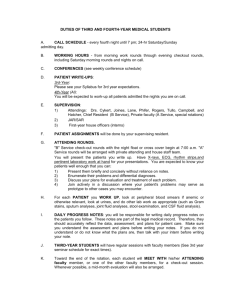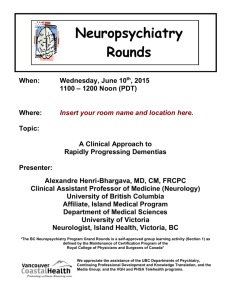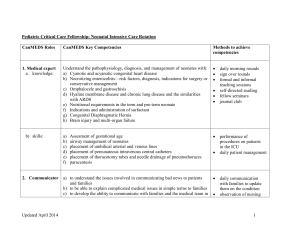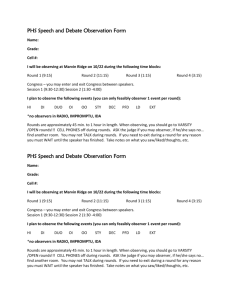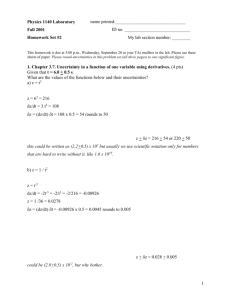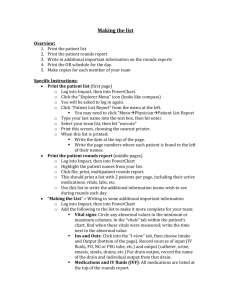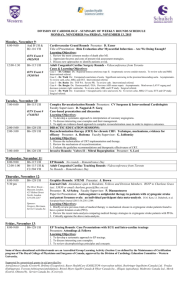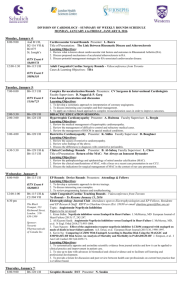Small Group Teaching in a Clinical Setting
advertisement
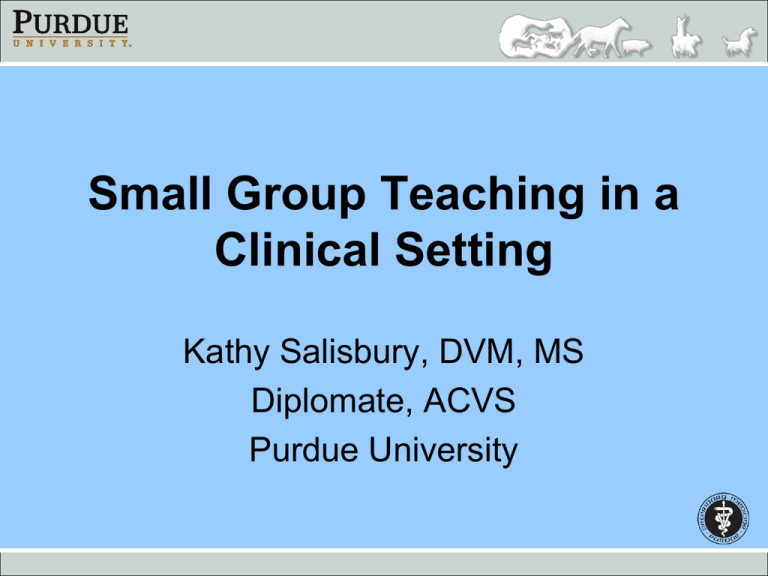
Small Group Teaching in a Clinical Setting Kathy Salisbury, DVM, MS Diplomate, ACVS Purdue University Small Group Clinical Teaching • Teaching goals and objectives • Types of clinical teaching • Your role in creating the learning environment and motivating students • Student evaluation Goal of Clinical Teaching Produce competent veterinarians who are critical thinkers and can function independently Determining Learning Objectives • Preparation for entry-level practice • Consider your course in the context of the whole curriculum • What has been covered previously? – Hold the students accountable Determining Learning Objectives • Cannot “cover” all content in your area • What is relevant to the goal of entry-level competency? • Identify key content in your discipline • Focus on application of knowledge Determining Learning Objectives • Focus on the overarching competencies – History-taking – Physical examination skills – Identifying problems, DDx list – Dx work-up, interpretation – Formulating treatment plans – Communications with clients, staff Determining Learning Objectives • Promote critical thinking, decision-making • Instill the behavior of lifelong learning • Facilitate the transition to being the doctor – Active involvement – Accept responsibility – Create opportunities for students to be the doctor Define Expectations • Don’t assume that students know what you expect • Clearly articulate your expectations – Behavior, attire – Preparation – Participation – Procedural protocols – What to do in case of illness, personal problem Define Expectations • Communicate the learning objectives to the students • Help the students set realistic expectations • Involve the students--ask them what their goals are for the rotation Choose teaching techniques that will promote the learning objectives Lecture ≠ critical thinking Teacher-centered learning vs Student-centered learning Student-centered learning promotes development of: • • • • Critical thinking Independent, lifelong learning Communication skills Teamwork skills Teaching Opportunities in the Clinic • Rounds – Topic rounds – Case rounds • One-on-one over cases • Daily interactions – Role modeling Topic Rounds vs Case Rounds • Topic rounds – Good way to consistently address specific content in each rotation – Can become a teacher-centered lecture • Case rounds – Patient a vehicle for exploring many different aspects of case management – relevant – Easier to promote application of knowledge – Housekeeping vs teaching rounds Rounds • Avoid telling them everything in the book but share your clinical expertise • Discuss alternative case management strategies and decision-making • Discuss financial/business aspects – Critical to success in practice • Encourage active discussion Learning Environment The learning environment has a profound effect on student learning Learning environments that are positive and supportive promote learning Your attitude and behavior have a profound effect on the learning environment and student motivation The Ideal Learning Environment • • • • • • • • Safe Low stress Encouraging Fun Allows practice Accessible Allows mistakes—low risk Provides immediate feedback Create a safe learning environment • • • • Clearly articulate expectations Be consistent Be fair Be understanding when appropriate – Allow extension on medical records when no sleep due to emergency Create a safe learning environment • Encourage questions • Encourage students to take risks – Cheerleader—”You can do it!” – Protect patients from serious mistakes • Encourage teamwork Foster teamwork We are on the same team with the same goal We want them to succeed Make learning FUN! Engage the students! Respect students’ time • Follow through with time commitments – Rounds start at 8:15 a.m. • Make discussions relevant • Be cognizant of students’ other responsibilities – Fatigue – Time of day – Offer to help Show that you care • Show genuine concern for each student and he/she will put forth greater effort • Treat students as individuals • Be compassionate Show that you care • • • • Respect your students Treat each student fairly and equally Invite questions Listen to student feedback Mutual trust is critical in the student-teacher relationship Treat your weakest student as you treat your best student Expect them to succeed Avoid Bias • Try not to let pre-conceived perceptions about a particular student’s abilities or performance affect your expectations of that student • Each rotation should start with a clean slate Challenge your students… …but show them how to succeed Students need to believe the goals are attainable Too little challenge Don’t try Too much challenge Demotivate Maintaining standards is critical • Set high standards • Clearly articulate your expectations • Be consistent in enforcing standards Refrain from giving students the answers • Give students the opportunity to figure out the answers themselves • Encourage students to become independent learners What do YOU want to do? Questioning can be an effective teaching tool • Give students the time to answer • Avoid embarrassing or belittling students • Know when to stop questioning Challenges to Clinical Teaching • Limited control over schedule • Caseload unpredictable • Emergencies • Client demands • Dependence on others Challenges to Clinical Teaching • Multiple groups of students with differing needs – Veterinary students (some with different educational backgrounds) – Interns – Residents • Concurrent demands on your time – Meetings, lectures, labs Try to protect some time every day when teaching is the priority Student Evaluation Evaluation methods drive the learning process Match the evaluation process to the learning objectives Provide Feedback • • • • • Timely Specific, concrete examples Provide appropriate positive feedback Be honest Specific suggestions for improvement Effective feedback builds students’ confidence • Improperly delivered feedback can destroy students’ selfconfidence • Too much feedback can be overwhelming Giving feedback in the group setting • Treat all students equally • Do not embarrass students • Provide compliments as well as suggestions for improvement • Feedback should be constructive rather than punitive • Admit your mistakes Importance of Feedback • Feedback drives learning • Give feedback on non-technical skills as well as technical skills and knowledge • Students need to know how they are perceived • We need to help students learn how to accurately self-assess Documentation • Clinical grading is largely subjective • Document in writing feedback that you provide to students, particularly if student is failing – Helpful to student – Evidence to defend grade appeal • Warn students of unsatisfactory performance with sufficient time for them to improve What are my responsibilities as a teacher? • Be prepared • Be organized • Be accurate • Be a positive role model • Provide feedback 3 Keys to Motivating Students to Learn • Enthusiasm • Show you care • Encouragement Clinical Teaching • You can have a profound effect on the learning experience • Respect students and empower them to be the doctor – Include students in case discussions – Minimize busy-work • Encourage critical thinking and independent decision-making The Continuum
